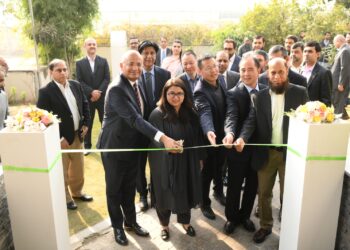The Asian Development Bank (ADB) has projected that Pakistan’s economic growth will slow significantly in the ongoing fiscal year 2024-25, estimating a modest growth rate of just 2.5%. This is one of the lowest projected growth rates in South Asia and underscores the continuing challenges facing the country’s economy. The ADB’s findings were published in its latest report, which also provided cautious forecasts for the next fiscal year and highlighted major risks to economic stability.
ADB Forecast: Key Highlights
- Current Fiscal Year Growth: 2.5%
- Next Fiscal Year Growth (2025-26): 3%
- Inflation Rate: Expected to remain at 6%, second-highest in South Asia after Bangladesh
- Major Risks: Political instability, weak reform implementation, climate change
- Positive Development: Improved macroeconomic stability under IMF program
Regional Context: Pakistan Among the Slowest Growing Economies
In its comprehensive regional review, the ADB compared Pakistan’s economic performance with other countries in South Asia. While several neighboring economies such as India, Bangladesh, and Sri Lanka are showing signs of recovery and stronger growth, Pakistan continues to lag behind due to a combination of internal and external challenges.
The report makes it clear that without consistent structural reforms and long-term economic planning, Pakistan risks falling further behind in terms of competitiveness and socio-economic development.
Political Instability Erodes Economic Confidence
One of the major concerns raised by the ADB is the ongoing political uncertainty in the country. The report cautions that political tensions continue to erode investor confidence and delay critical policy reforms. In the absence of a unified and stable political environment, economic planning and foreign investment remain vulnerable.
The bank stressed that the continuation of political instability could have far-reaching effects on both domestic business sentiment and international financial engagement, thereby undermining macroeconomic gains made in recent months.
Inflation: A Persistent Challenge
While inflation in Pakistan has shown signs of decline, it remains one of the highest in the region. The ADB forecasts an average inflation rate of 6% for the ongoing fiscal year, placing Pakistan just behind Bangladesh in terms of consumer price increases.
The report attributes the decline in headline inflation to:
- Lower global commodity prices
- Reduced domestic demand
- Policy measures by the central bank
However, the ADB also pointed out that core inflation remains high, reflecting persistent cost pressures across sectors. It warned that inflation is expected to rise again in the coming months due to potential energy price adjustments, currency depreciation, and supply chain disruptions.
Climate Concerns: Drought Threatens Food Security
A particularly alarming aspect of the ADB report is the mention of climate-related risks. The bank highlighted that drought conditions across various parts of the country could severely impact agricultural productivity. Agriculture remains a vital component of Pakistan’s GDP and a primary source of livelihood for the rural population.
If rainfall remains below average in the upcoming monsoon season, there is a high risk of reduced crop yields, which could lead to food shortages and a surge in food prices. The ADB urged policymakers to enhance investment in climate-resilient infrastructure and ensure that contingency plans are in place to deal with potential food insecurity.
IMF Program Brings Temporary Stability
The report acknowledged some recent improvements in Pakistan’s macroeconomic indicators, crediting the International Monetary Fund (IMF) program for playing a key role in restoring a degree of stability. Measures such as fiscal tightening, increased revenue collection, and policy reforms have provided short-term relief.
However, the ADB was quick to caution that this stability is fragile and conditional upon the government’s ability to adhere to the reform agenda. Any deviation or reversal could lead to renewed financial stress.
Infrastructure Deficit Remains a Bottleneck
Despite the slight improvements in macroeconomic stability, Pakistan continues to struggle with an aging and underdeveloped infrastructure network. The ADB identified this as a major constraint to economic growth and competitiveness.
Poor transportation links, inadequate energy supply, and limited access to clean water and sanitation continue to hamper industrial output and agricultural efficiency. The bank emphasized the need for targeted investments in infrastructure to unlock productivity gains and boost employment.
Current Account Deficit Still a Major Concern
Pakistan’s current account deficit remains a persistent issue, and the ADB expects it to continue into the current fiscal year. Although exports have seen marginal improvements, the country’s import bill remains high due to energy and capital goods purchases.
To reduce the pressure on foreign exchange reserves, the ADB recommends:
- Diversifying the export base
- Encouraging remittances through formal channels
- Strengthening foreign direct investment (FDI) flows
Recommendations for Sustainable Growth
To address the challenges identified in its report, the ADB outlined several key policy recommendations:
- Maintain Reform Momentum: Strong commitment to ongoing fiscal, monetary, and structural reforms.
- Foster Political Stability: Ensure a cohesive and transparent political environment to build investor confidence.
- Invest in Infrastructure: Focus on energy, transportation, and digital connectivity.
- Strengthen Social Safety Nets: Support vulnerable populations affected by inflation and climate shocks.
- Enhance Climate Resilience: Prioritize water conservation, afforestation, and climate-smart agriculture.
- Promote Economic Diversification: Reduce dependency on a few sectors and broaden the industrial base.
Conclusion
The Asian Development Bank’s latest economic outlook for Pakistan presents a mixed picture. While macroeconomic stability has improved due to the IMF program, the country still faces numerous headwinds, including political instability, inflationary pressures, infrastructure deficits, and climate risks.
With projected economic growth of just 2.5% this fiscal year—the lowest in the region—Pakistan needs urgent and sustained efforts to restore economic confidence, improve governance, and lay the groundwork for long-term development. The report serves as a wake-up call for policymakers to accelerate reforms and ensure inclusive and sustainable growth for the nation.

























